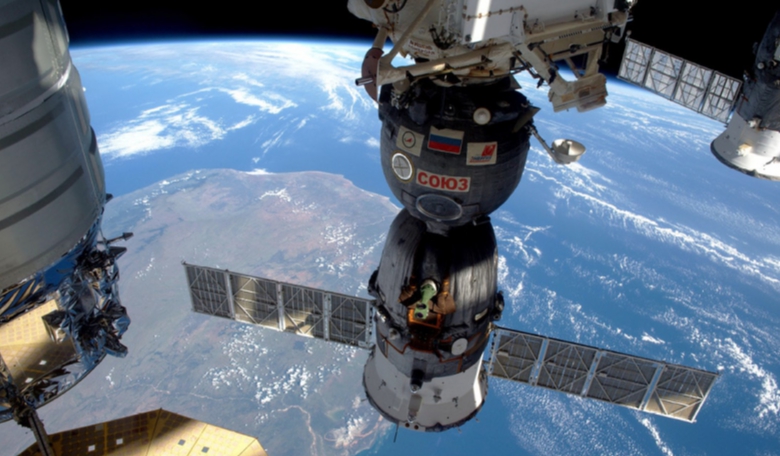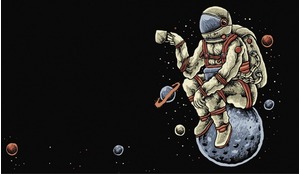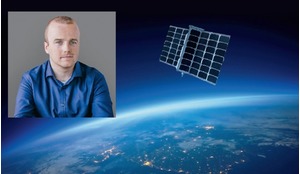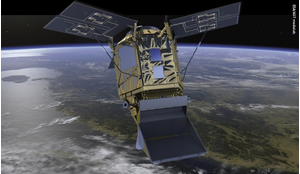Compared to routine operations in low Earth orbit, the allure of interplanetary exploration is almost irresistible. Ultimately, space stations like the ISS are an essential building block and training ground for future interplanetary exploration. So, despite the questions and political debate, many nations and their national agencies aspire to reach the stars. This is reflected in space programmes across the world that pump in vast amounts of money and resources towards similar goals of interplanetary exploration.
Duplicity of effort is rampant and today there still exists a situation wherein nations tend to pursue planetary exploration largely in isolation, often reinventing the wheel at an enormous cost.
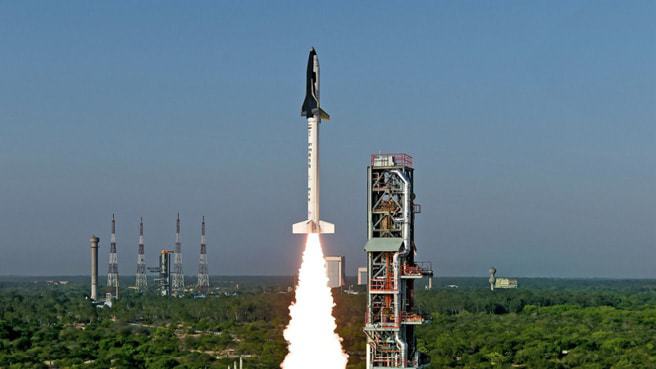 The Indian Space Research Organisation (ISRO) successfully tested a prototype of a reusable space shuttle on 23 May 2016. The Reusable Launch Vehicle Technology Demonstrator (RLV-TD), which is about six times smaller than the final planned space shuttle, spent a little less than 13 minutes in flight before landing. Some 600 scientists at ISRO have been working on the agency’s shuttle programme for a decade now and it is likely to be another 10 years before the first full-size vehicle is ready for launch.
The Indian Space Research Organisation (ISRO) successfully tested a prototype of a reusable space shuttle on 23 May 2016. The Reusable Launch Vehicle Technology Demonstrator (RLV-TD), which is about six times smaller than the final planned space shuttle, spent a little less than 13 minutes in flight before landing. Some 600 scientists at ISRO have been working on the agency’s shuttle programme for a decade now and it is likely to be another 10 years before the first full-size vehicle is ready for launch.
Part of this tendency, can be seen as a ‘residue’ of the World War 2 and Cold War eras when competition in outer space rather than international cooperation was the prime mantra. In the prevailing era of globalisation the barriers have slowly been coming down - it makes enormous technological, economic and social sense to cooperate and pool the unique strengths of nations otherwise our journey to the stars becomes a lonely and almost impossibly expensive one.
Technically, there exists no question of sovereignty in outer space and hence the usual terrestrial disputes need not prevail. But as regular readers of ROOM will be well aware there is currently no space version of the Treaty of Westphalia, which signalled the end of the great 30 year war. Despite the current efforts of law-makers, what applies on land does not yet do so in Earth orbit and beyond.
By far the largest number of disputes around the world are territorial and since prevailing space legislation, particularly Article I and II of the Outer Space Treaty 1967, forbid claims to sovereignty in space, it would seem to make sense to drop the Westphalian concept of nation states on Earth before reaching out to space. It makes political and legislative sense to cooperate rather than transfer earthly competition and conflict to outer space. It also makes economic sense in equal, if not greater measure.
Cooperation enables nations to mitigate challenges and strengthen capabilities, and the types and areas of mutual exchange are many and varied. For example, a nation like India is managing to dodge the exorbitant cost of space activities. Its space agency boasts a budget of nothing more than US$ 1 billion and has invested in practical societal applications - there are currently some 32 operational spacecraft serving its population of tens of millions in many ways.
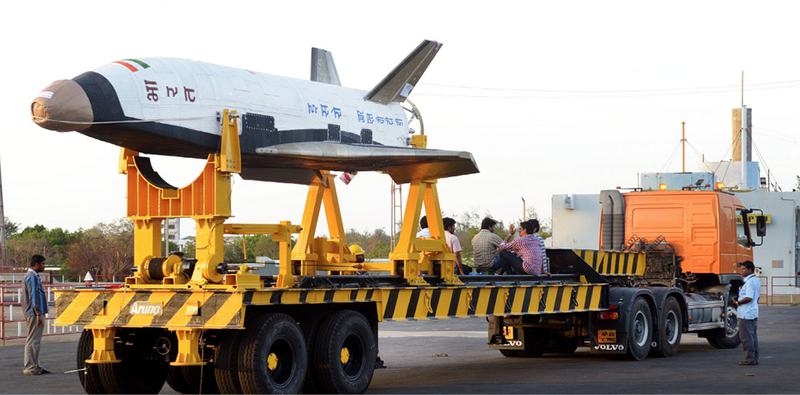 India’s space programme touches the everyday lives of its people in numerous ways ranging from town planning and banking to agriculture and fishing. A frugal appr oach and India’s organisation model provides
India’s space programme touches the everyday lives of its people in numerous ways ranging from town planning and banking to agriculture and fishing. A frugal appr oach and India’s organisation model provides
India’s space programme touches the everyday lives of its people in numerous ways ranging from town planning and banking to agriculture and fishing. A frugal approach and India’s organisation model provides lessons in reducing costs - yet, India could further mitigate its technological and economic challenges by extending its cooperation with other space faring nations.
The country has a cost-effective space programme that serves the common man well and yet complacency is not an option if it wants to continue serving its millions with a relevant space programme that delivers both real benefits and inspiration. Ultimately, nations will have to evolve beyond Earth orbit.
The possibility of China cooperating with other nations in space station operations presents a new-found opportunity
Planetary exploration, inclusive of orbiting space stations and missions to the Moon, asteroids and Mars, are the way of the future - and the future will demand that nations progress accordingly, balancing technological with economic issues. Investments will be huge and so it will make sense to cooperate and share the costs, as well as the benefits.
This rationale of cooperation applies not only to developing nations but equally to those that prefer economic prudence to profligacy. The existing and foreseen climate of economic recession across the globe no longer permits the luxury of the latter. In this light, the possibility of China cooperating with other nations in space station operations presents a new-found opportunity to nations across the globe to advance despite technological and economical hurdles.
A rationale for cooperation
The International Space Station orbiting at 400 km is a joint endeavour of the US, Russia, Canada, Japan and 10 European nations but with no Chinese or Indian participation. It was launched in 1998, originally to be decommissioned in 2015 but this was postponed and its life is now extended until 2024 or possibly beyond.
Such a life extension is again costly. Ever since the US retired its Space Shuttle in 2011, NASA pays Russia US$70 million a seat to send its astronauts to the Space Station. Apart from costs, the Ukraine crisis is expected to ultimately take a toll on US-Russian space relations. And though progress is certainly being made, transporting astronauts to orbit via private American spaceflight technology remains quite some time away. The situation appears grim in the west - and so one looks to the east also.
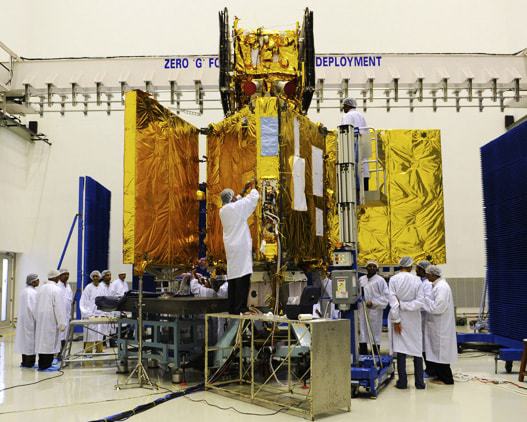 RISAT-1, a microwave remote sensing satellite carrying a Synthetic Aperture Radar (SAR) payload, undergoing tests prior to its launch in April 2012.
RISAT-1, a microwave remote sensing satellite carrying a Synthetic Aperture Radar (SAR) payload, undergoing tests prior to its launch in April 2012.
As the ISS approaches the end of its planned life, China’s ‘Heavenly Palace’, the Chinese Space Station (CSS), is likely to be fully operational by 2024. As it is, China’s efforts appear impressive considering that its prototype station Tiangong-1 has been in orbit since September 2011 and Chinese astronauts or taikonauts have made as many as five visits and numerous experiments on board to date. There exists a unique opportunity to both the west and east to fulfill an expressed desire to cooperate.
This new-found opportunity could serve many purposes. For instance, India, though an established space faring nation, finds space stations costly but has plans for Mars and crewed missions. On the other hand, a small country such as Indonesia has harboured its own ambitions for human spaceflight since 1985. Situated right on the equator, it is most ideally placed for launches and yet it certainly doesn’t have the means to fulfil its aspirations.
A variety of nations have similar aspirations, together with unique strengths that can be pooled together to reduce the overall load of a given space activity. The costs and efforts of space endeavours are enormous and it makes a lot of common and economic sense to piggy back on existing efforts. Both China and the US are open to participation - the US for research on the ISS and China for training foreign astronauts on its space station. Prudence demands a dispassionate look at such choices as one potentially serves present needs and the other the future.
Diplomacy as an enabler
The opportunities are aplenty and, divested of the usual suspicious frames of reference, there exists enormous scope for civil collaboration, cooperation and mutual gain. The emotional baggage of competition, rivalries, conflict and other earthly issues need not necessarily be transferred to outer space.
If the US can mull cooperation with China on the CSS after keeping it out of the ISS, there exists no reason why other nations cannot look at international partnerships afresh. Cooperation rather than conflict in space should be the new mantra and prudence dictates a duty to share efforts in the endeavour today in order to share the spoils tomorrow. It would serve nations well to closely look at the shifting patterns and adapt accordingly.
Prudence dictates a duty to share efforts in the endeavour today in order to share the spoils tomorrow
It is here that the services of the velvet glove of diplomacy come into play. Space enables mutual gain and it augurs well for the diplomatic apparatuses of nations to explore areas of cooperation. The scope is substantial since resources essential to space exploration are scattered across the globe and singular efforts have not always yielded much. Consolidating the human, technological, geographical and economic resources to attain the collective goal of human advancement by planetary exploration makes eminent sense.
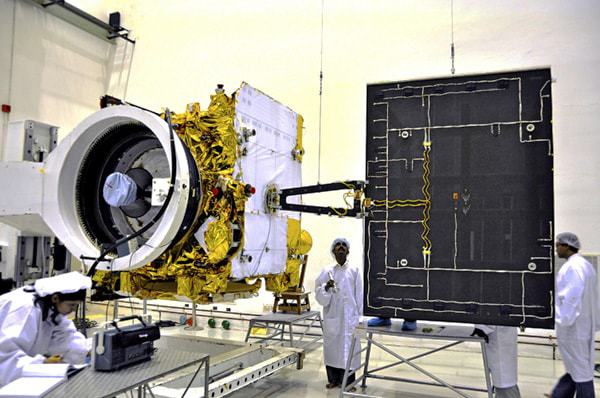 India’s GSAT-12 communication satellite launched by ISRO in July 2011
India’s GSAT-12 communication satellite launched by ISRO in July 2011
A variety of technology and cost-sharing models could be worked upon. For instance, apart from the potential benefits that would accrue to nations like the US, Europe, Russia and China - which already possess varied levels of space station competencies - aspiring nations like India could also gain significantly in exchange for competencies in launch, medicine, software, etc.
After all, India’s Mangalyaan successfully entered Mars orbit on its first attempt while China’s splashed back into the ocean and the US made it only after losing quite a few Mariner Mars missions. On similar lines, ESA has established competencies in specific areas of planetary exploration, as has the Japanese Space Agency (JAXA).
Besides technology, the geographical location of nations on the equator could be more gainfully utilised for launch and recurring logistic support to orbiting space stations. As of now, all these global capabilities lie dispersed and the energies and efforts are unconsolidated and significant gains are frittered away. Cooperation would serve to conserve resources and streamline efforts.
Precise areas of cooperation, modalities and terms of reference etc would follow once nations really open up to the idea of space cooperation. Instead of expending resources singly and experiencing cycles of failures and success, it makes sense (both common and monetary) for parties to cooperate.
In space, stars with a mass higher than the Chandrasekhar limit collapse into themselves to become black holes of intense gravity from which even light cannot escape. Cooperation keeps nations beyond the Chandrasekhar limits of over-expenditure in space and would enable space to be exploited more effectively and optimally. International cooperation is the connecting glue that helps dodge the black holes en route to humanity’s progress in space.





